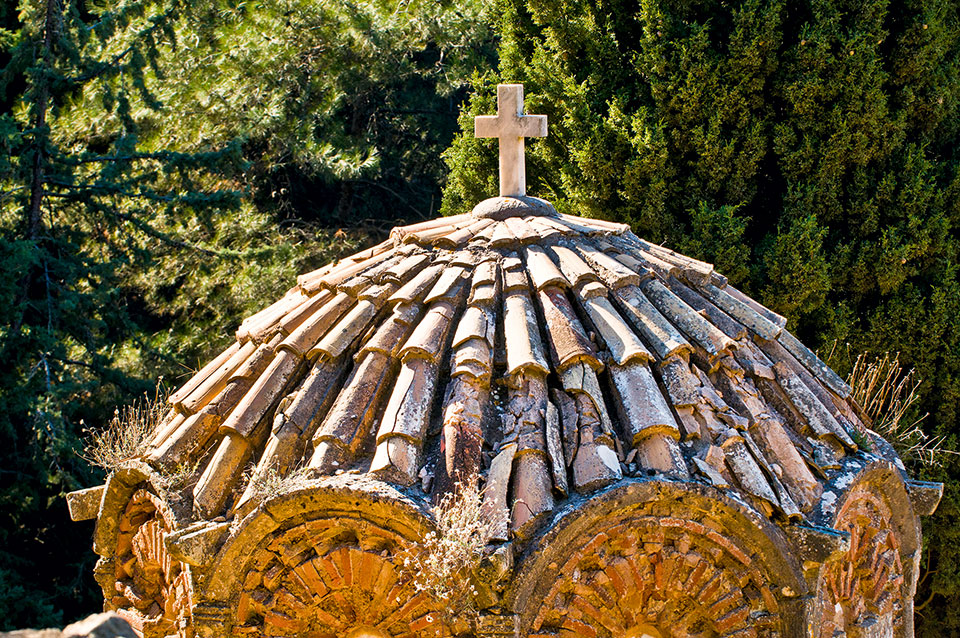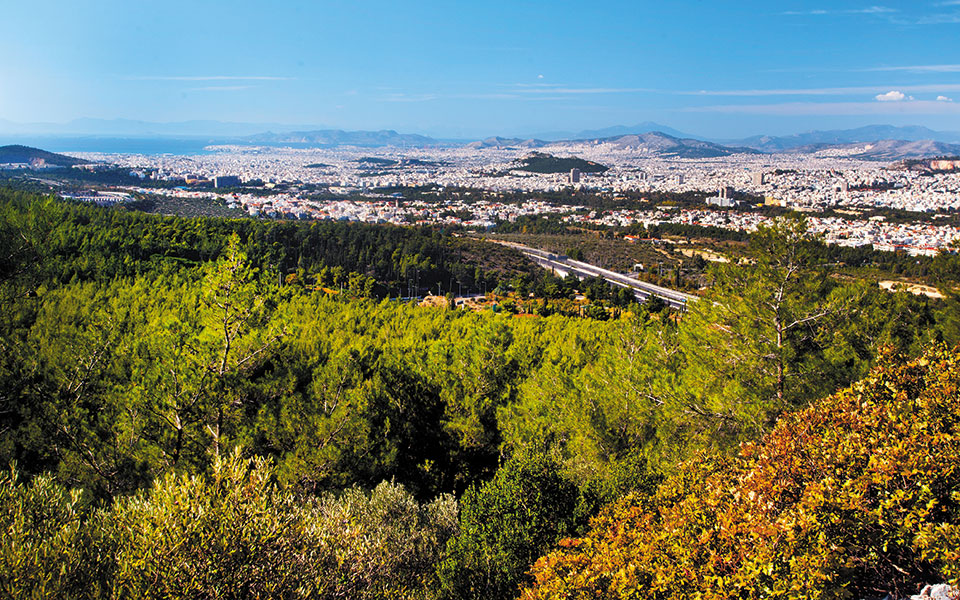It took me 20 years – and a pandemic – to realize that Mt Ymittos is only a 58-minute walk (watch in hand) from the door of my building.
High up on the mountain, what I saw was like an inversion of the metaphor of the sprawling concrete jungle. An initially narrow green strip that starts a few meters away from the Hilton Hotel (in the often overlooked park of Alsos Ilision) progressively expands in width, as it crosses the University of Athens’ Zografou Campus.
This stream of green cascades down from the mountain, reaching almost the very center of the city. Alsos Ilision is a five-minute walk from Vasilissis Sofias Avenue and from there, you need 50 minutes to reach the foothills of Mt Ymittos proper.
Isn’t that incredible?

© Dimitris Rigopoulos
Starting Point
This is a green walk on the doorstep of inhabitants of Pangrati, Ilisia and the famous “Behind the Hilton” area – which became a popular urban destination after the construction of the famed hotel in the 1960s.
Take the entrance to the park of Alsos Ilision as a starting point – either from Diocharous Street opposite Andreas Syngrou Hospital, or from the church of Aghios Haralambos on Ion Dragoumi Street.
Do not feel bad if you have never heard of Alsos Ilision before, even if you live in the neighborhood; many an Athenian is ignorant to its existence. And yet, Alsos Ilision (also known as Alsos Syngrou – not to be confused with the Syngrou Estate in Marousi) is one of the largest green oases in the center of Athens, with an area equal to that of the city’s National Garden.
We owe this oasis to Crown Princess Sophia and her determination to “green” the then young capital in 1909, much of which was a largely barren landscape. That year saw the emergence of initiatives to create parks and groves in different areas of the city; one of them was the Alsos Ilision.
The area we are referring to was of course, completely unbuilt at the time; the woman who would go on to be queen was truly seeing ahead.

© Dimitris Rigopoulos
The park extends over a small hill and is covered with Aleppo pines. It possesses an internal path network bordered by playgrounds and stone benches.
For some reason, its present neglected state reminds me of Eastern Europe before the fall of the Berlin Wall. I’m not exactly sure why: perhaps it’s the good intentions of a distant, nobler past, as evidenced by the brick paths and the built fountains in which water never ran, alongside the graffiti, the resolute runners and the innocent couples walking under old pines that transport me to Sofia or Bucharest of the 1980s.
Keep walking steadily towards the northeast until you reach Nikolaos Chlorou Street that runs through the park and which will take you to Oulof Palme Street. Take a right and keep going until you reach the traffic light, and cross over to the Zografou Campus.
A different world begins here, which, if you are not a student or a resident of the area, is worth discovering with the innocent thrill of a first-time explorer.
The area is really big (130 hectares) and accessible to all. The buildings and internal road network occupy a small part of it; a few noteworthy examples of Greek post-war modernist architecture survive here – such as the Faculty of Theology.
The rest is occupied by outdoor sports facilities (in the southern part) and a dense forest of pine, olive and eucalyptus. We are in fact at the foot of Mt Ymittos. Take note however, as the way gets steeper around about the 6th bus stop: You are now ascending the mountain.

© Dimitris Rigopoulos
Forest therapy: A trend reinforced by lockdown
In Greece, the fences that in theory protect public spaces and property are most often laughable. They commonly have holes in many key spots, which can mean good or bad news.
In the case of the Zografou Campus, it’s good news; a convenient gap in the chain-link fence behind the building of the School of Science takes you to just outside the Aesthetic Forest of Kaisariani.
The guardhouse here, which is manned by volunteer firefighters during the fire season, remains empty this time of year. From here, one enters the paradise of Ymittos. I can’t think of another word to describe the magic of this mountain which for years lived in the shadow of Attica’s other two tall mountains: Parnitha and Penteli.
One day, it was discovered by a few, these few told their friends, and now Ymittos is a beloved destination for thousands of Athenians who walk, run, practice yoga, ride mountain bikes, or simply go up to chill and enjoy arguably the best views of the Attica basin.
If you feel up to it, I highly recommend you take path number 15 (marked in red) which starts off right after the guardhouse and lends itself to novice hikers. It takes approximately 20-25 minutes to reach the oasis of Kalopoula, but we are in no rush.
Pause, listen to the birds, gaze at the rays of sunshine filtering through the leaves, take your deepest breath. Little by little, step by step, walk up to the famous Kalopoula cantina, which fortunately remains open (from 7:30 to 15:00) – but only for a quick bite to go, not for its renowned fasolada (bean soup), as the kitchen is closed due to the current lockdown.
Under the right conditions, the forest has healing powers. It is not just any walk; contact with the soil, and nature at its most pristine grounds us in the present moment, reminding us of the things that truly matter. If this sounds too New Agey for you, think again. So-called “forest therapy” is one of the fastest growing practices in the Western hemisphere and seeks to reestablish city dwellers’ contact with the natural world.
So if you find yourself grumbling at the urban sprawl and clamor of Athens, remember that you have just read an account of an hour-long walk that takes you from the center of town right into the heart of a mountain forest. Where else can you do that?
This article was first published in Greek on kathimerini.gr












